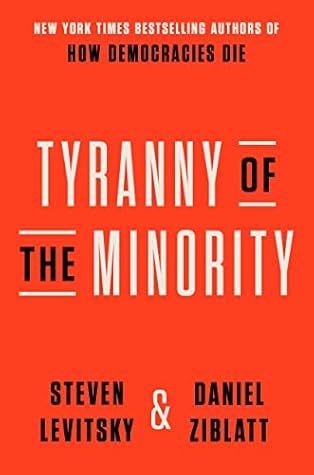More on this book
Community
Kindle Notes & Highlights
Read between
February 19 - February 20, 2025
A 2018 survey by the Public Religion Research Institute (PRRI) found that African American and Latino citizens were three times as likely as whites to be told they lacked the proper identification to vote and twice as likely to be told—incorrectly—that their names were not listed on voter rolls.
Laws barring convicted felons from voting disproportionately affect African Americans.
Meaningful steps toward democratic inclusion often trigger intense—even authoritarian—reactions.
In 2015, the United States received a score of 90, which was roughly in line with countries like Canada, Italy, France, Germany, Japan, Spain, and the U.K. But after that, America’s score declined steadily, reaching 83 in 2021.
America also differs in another way: extremist forces actually ascended to national power, whereas in Europe they have been largely confined to the opposition or, in a few cases, coalition governments.
Part of the problem we face today lies in something many of us venerate: our Constitution.
Electoral majorities often cannot win power, and when they win, they often cannot govern.
First, parties are most likely to accept defeat when they believe they stand a reasonable chance of winning again in the future.
A second condition that helps parties accept defeat is the belief that losing power will not bring catastrophe—that a change of government will not threaten the lives, livelihoods, or most cherished principles of the outgoing party
what made the day’s events so important was less the actions of the rioters in the streets themselves than the reaction of mainstream conservative politicians.
any party or politician that violates either of these two basic rules should be considered a threat to democracy.
When politicians from across the spectrum repudiate violent or antidemocratic behavior, it often isolates extremists, blunting their momentum and deterring others.
They tolerate or condone antidemocratic extremism because it is the path of least resistance.
If a behavior is not explicitly prohibited, that behavior—no matter how inappropriate—often becomes permissible.
Wherever nonenforcement of the law is the norm—where people routinely cheat on their taxes, businesses routinely flout health, safety, or environmental regulations, and well-placed public officials routinely use their influence to do favors for friends and family members—enforcement can be a form of constitutional hardball.
politicians may design new laws that, while seemingly impartial, are crafted to target opponents.
Democratic backsliding occurs gradually, through a series of reasonable-looking measures: new laws that are ostensibly designed to clean up elections, combat corruption, or create a more efficient judiciary; court rulings that reinterpret existing laws; long-dormant laws that are conveniently rediscovered.
The laws were adopted on seemingly reasonable grounds: combating voter impersonation fraud. But there were two problems. First, election fraud—especially voter impersonation fraud—is virtually nonexistent in the United States.
So voter ID laws were a solution without a problem, which means that their goal was almost certainly not preventing fraud.
Rather, their aim was making it harder for certain Americans—particularly Black, Latino, and poorer citizens—to vote.
But it is another thing for a partisan minority to consistently defeat or impose policies on larger majorities and, worse still, use the system to entrench its advantages. When this happens, you have minority rule, not democracy.
Geographic sorting and gerrymandering have produced what one analyst has called “manufactured majorities.”
the Democratic Party has, as we have noted, won the popular vote in all but one presidential election since the 1980s and every six-year cycle in the Senate since the 1990s.
How much faith should she have in our democracy?
only 37 percent of Americans approved of the decision to overturn Roe v. Wade.
55 percent of Americans identified as “pro-choice” while only 39 percent identified as “pro-life.”
61 percent of U.S. adults say abortion should be legal in all or most cases, while only 37 percent believe abortion should be illegal in all or most cases.
65 percent of Americans support stricter gun control laws, while only 29 percent oppose them. Broad public support also emerged for specific gun safety policies. Surveys by Gallup and Pew have consistently found more than 60 percent support for a law banning the manufacture, sale, or possession of semiautomatic or “assault” weapons and more than 80 percent support for laws requiring universal background checks for gun purchases. But such legislation has consistently failed in the U.S. Senate. This is, in part, because the Senate vastly overrepresents gun owners: the twenty states with the
...more
This highlight has been truncated due to consecutive passage length restrictions.
60 percent support for a law banning the manufacture, sale, or possession of semiautomatic or “assault” weapons and more than 80 percent support for laws requiring universal background checks for gun purchases.
In 2020, workers earning the federal minimum wage had about a third less money to spend each month on food and rent than they had fifty years earlier.
electoral arrangements that overrepresent certain territories or groups, allowing parties to win elections without capturing the most votes, weaken the incentive to adapt.
As long as the Republican Party can hold on to power without broadening beyond its radicalized core white Christian base, it will remain prone to the kind of extremism that imperils our democracy today.
study of the 2018 election found that on average Latino and Black voters waited 46 and 45 percent longer to vote, respectively, than white voters.


